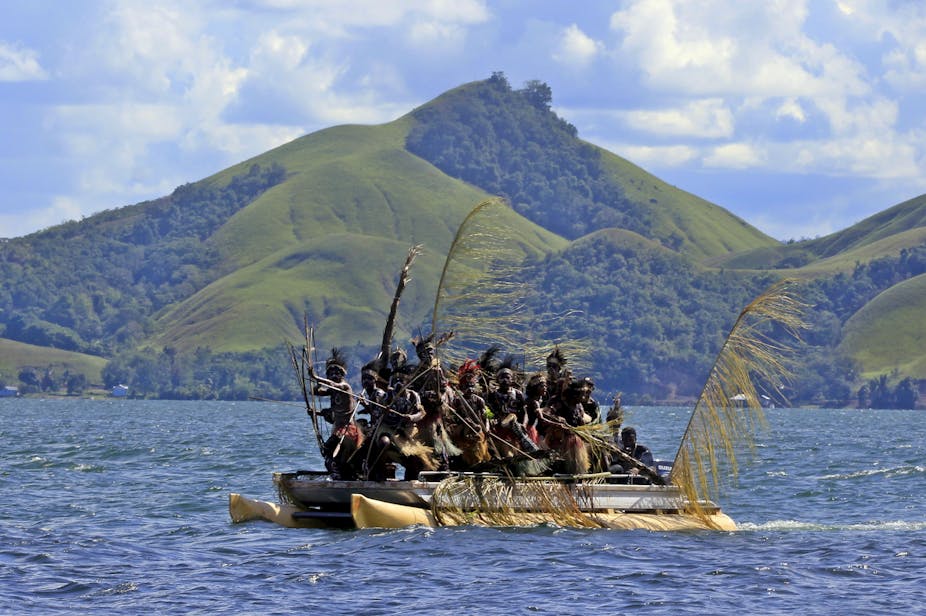Online discussion about the conflict over independence in Indonesia’s easternmost provinces — the Papua conflict — is a fiercely contested space.
The Indonesian government has employed internet shutdowns and taken punitive action against government critics to obstruct the free flow of information. Critics of Indonesian governance in Papua also frequently face online harassment.
In our new paper published in the Harvard Kennedy School Misinformation Review, we highlight a flood of Indonesian-language pro-government disinformation on Twitter since February 2021, promoting Indonesian government narratives on special autonomy.
Along with repression of the independence movement, special autonomy has been a key element of Indonesian governance in Papua. Dissatisfaction with special autonomy has grown over time in Papua, with Papuan activists rejecting the policy.
Ahead of the July 2021 decision by Indonesian authorities to extend special autonomy for a further 20 years, thousands of Twitter users engaged in a large-scale campaign on the platform in support of the policy.
Our study observes that although these Twitter users were ostensibly unconnected, their posts and profiles strongly suggest that a single entity was directing all these accounts.
Inauthentic pro-government posts on Twitter
There are three key reasons behind that observation:
First, these accounts mostly posted at the same time of day. Initially, their posts were concentrated in the minute starting 6:55am (Jakarta time). Then, once the Islamic fasting month began on April 13 2021, the accounts abruptly switched en masse to posting in the minute starting 8am (Figure 1).

The concentration of tweets in these two minutes in early 2021 is so anomalous that they show up as dark vertical bands if we plot the time of day that Twitter users posted all 1.25 million Indonesian language tweets in our dataset, over the course of 2.5 years (Figure 2).

Second, beyond their synchronicity, the tweets shared an additional characteristic – most contain nearly identical text. At face value, 22,479 of the 23,853 tweets in our dataset posted in these two minutes are “original” tweets (not retweets) about special autonomy, posted by 2,668 different authors.
Only 760 of these original tweets are unique, as measured by a test that checks how similar two pieces of texts are, called a Jaccard similarity test. The remainder are duplicates or near duplicates of only 1,329 distinct tweets, with the most duplicated example repeated in 286 versions.
Figure 3 presents an example of one such set of 10 duplicates. The content of these 1,329 sets of duplicates aligns closely with contemporaneous Indonesian government messaging on Papua. Two-thirds praise Indonesian government policy, including the staging for the first time of Indonesia’s National Games (PON) in Papua in 2021. A substantial proportion — around 17% — also either quote indigenous Papuans expressing pro-government positions or assert that indigenous Papuans support special autonomy.

Third, the accounts posting original tweets about special autonomy in these two minutes of the day differed in systematic ways from other Twitter users in our dataset.
Half of the accounts (50.9%) had a blank author description, compared to just 18.7% of accounts in the rest of the dataset. Only 32% used a profile picture featuring an identifiable person – based on a random sample of 100 accounts – and scrutiny of these pictures suggested many were unlikely to be the account holders.
The accounts were also of atypically recent provenance. By the time of their median date for account creation on 28 March 2021, 99.1% of accounts in the dataset had been created. As of October 2022, Twitter had suspended 64% of these accounts since we scraped the dataset in June 2021, compared to 2.2% of accounts in the rest of our dataset.
Together, these features clearly mark this set of tweets and accounts as inauthentic: the notion that they are distinct accounts, making spontaneous posts about special autonomy, is untenable. It is this false notion about the nature of the tweets and accounts that marks this campaign as disinformation, rather than the content of the tweets being mostly false.
Some of the duplicated tweets are demonstrably false, and others make dubious but unverifiable statements. But many others are factual statements of elements of Indonesian government policy on Papua, albeit combined with a contested statement that these details show that special autonomy should continue.
How does this affect social media users?
So the inauthentic tweets are there – but what effect did they have on their intended audience’s views of Papua?
Such a question might be even more pointed in the case of a disinformation campaign lacking sophistication, where duplicate tweets were insufficiently paraphrased to evade detection by a simple similarity test, and most received almost no engagement from other Twitter users. Certainly, the campaign lacks a clear mechanism to change the minds of social media users who happen upon it.
Nevertheless, this campaign’s sheer scale means it cannot easily be discounted as insignificant: the 1,329 sets of duplicate or near duplicate tweets posted in just two minutes of the day make up 14.0% of all original tweets mentioning special autonomy over the 2.5 years of our dataset, and 7.9% of all tweets on special autonomy including retweets.
These tweets are so numerous that they make it nigh on impossible for all but the most committed reader to understand the true outlines of the debate on special autonomy – so-called “zone-flooding”.
Coupled with restrictions on genuinely independent reportage and free expression in Papua, the scale of this campaign thus demonstrates the ability of pro-government actors to employ social media disinformation to constrict democratic discourse.


